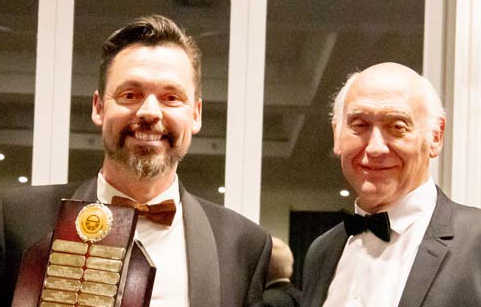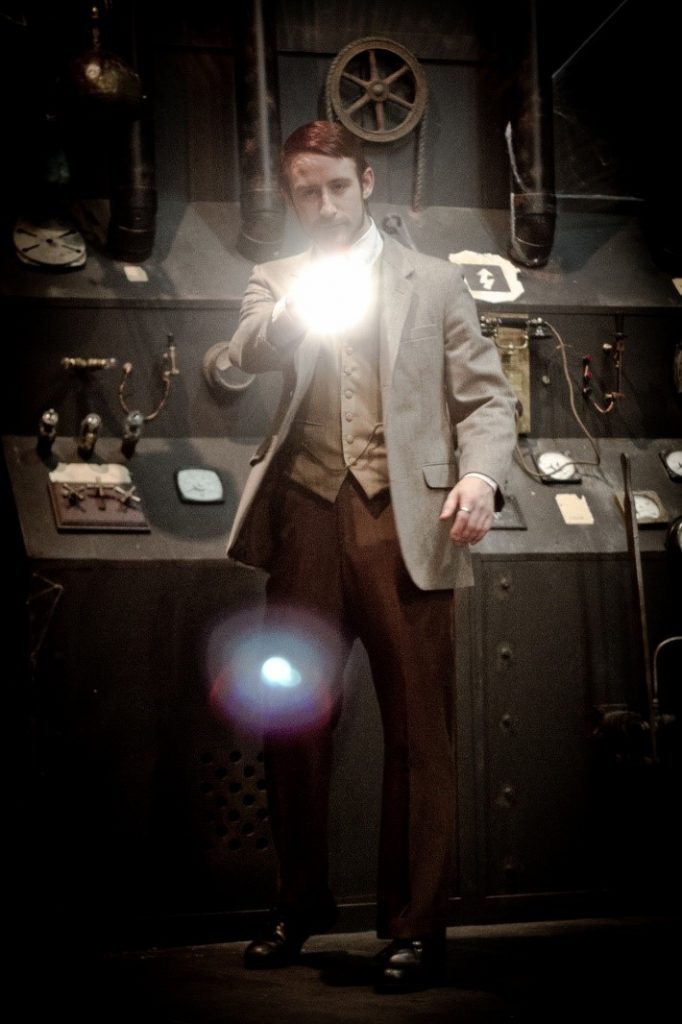Justin Stephens has emerged as an imaginative director of varied productions, sometimes with reference to what is termed ‘Steampunk’, a genre of science fiction that has an historical setting and typically features steam-powered machinery rather than advanced technology. In 2019 his production of ‘Baskerville: A Sherlock Holmes Mystery’ for The 1812 Theatre was successful in multiple categories of the VDL Awards including Best Director and Best Production: Comedy.
VDL President Bruce Cochrane chats with Justin about his approach to including a different perspective to his choice of plays.

‘Baskerville: A Sherlock Holmes Mystery’. Pictured with Bruce Cochrane, VDL President
Bruce: Justin, how did you become interested in Gothic styling, or more specifically ‘Steampunk’ as applied to theatre, and thus shows you would produce and direct?
Justin: I can’t recall the first time I came across this form of art. I’m often drawn to stylised story telling in cinema.
There’s something fascinating about current or future technology appearing in a time and place that it shouldn’t. Perhaps I can relate to that in some way personally. The early work of Tim Burton has been a source of enjoyment and disturbance for a long time. When I directed ‘A Skull in Connemara’ I wanted to bring something of that type of ‘other world’ to the set and soundscape. This was taken further with ‘The Woman In Black’.
I wanted to weave in the Victorian era story with believable technology twists, giving the well-known production a fresh look. This was a lot of fun. We spent a lot of time on the details with costumes, props and of course the set. I suppose I’ll be attracted to productions that lend to this style although I’ve done plenty that don’t.

Bruce: How do you find that connects with the sort of audiences that we normally expect to play to?
Justin: I’m not sure! It’s a gamble each time. Honestly, I am thinking of myself as an audience member in the first instance and if it’s something that connects then I assume, or hope, there are others who will connect to it as well. I feel we accept new or different things when they have something familiar about them, when the audience is presented with something they haven’t seen before and yet it has elements they can relate to. The exciting challenge is to try and do all this and maintain a quality that doesn’t take the audience out of the show.
Bruce: So, it requires that you have total involvement of all facets of production. Is there any conflict from other creatives or committee who may want to express their doubts?
Justin: I don’t think there is a director around that hasn’t had some kind of challenge with pitching their vision or choice of production at one time or another. Once I have personally connected with the story and the way I see it being told I can get fairly excited and perhaps the enthusiasm helps. Being involved in each aspect of production is the role of the Director, and it’s important to me that the collaboration is maintained across the entire production team. When there is strong collaboration and team involvement, I don’t find too many conflicts arise.
Bruce: How hard is it to ‘sell’ the concept to a theatre company accustomed to choosing plays that are ‘safe’ as entertainment for their usual patrons?
Justin: I’ve not found it particularly hard or rather I haven’t had any serious push-back on play choices. Community Theatre does need to consider their core audience when balancing out their season. You can only take so many ‘risks’. Regardless of the play choice I think quality is something audiences are looking for. If the quality is consistent the audience, I believe, will be with you.
Bruce: As a director, I’ve always listened closely to audience reaction, either while watching performances or in the foyer at interval and post show. Not because I’m looking for endorsement of my work but just to sample the variation of perspective. Have you been surprised at the range of response to your application of Gothic style?
Justin: I’m always surprised when someone comes up to provide feedback. It’s not something I think should be happening to me I suppose. I think it’s a real privilege to be able to do something that engages an audience. It’s always lovely when someone comes up to tell you how the show made them feel or some kind of personal experience, they had that connected them to the production. With a very stylised production the aim is to take the audience away from whatever they are worried about and into another world for 2 hours and hopefully come out the other side entertained or moved in some way.
Bruce: So, it’s critical that you are able to communicate as much as possible of your vision to cast and crew so that you can take them along with you.
Justin: This is one of the most important things for me. I’ll tell the story, learn a lot of the lines beforehand, show concept artwork, set design, play bits of soundscape, do almost anything to paint the picture. I try to communicate this to every single person in the production as a group or personally. It’s so important that everyone in the team knows how their involvement directly impacts the final result.
Bruce: Your next show, rescheduled, will be ‘Let the Right One In’ at 1812 and for those who have seen the film it’s been described as a Swedish romantic horror film. So, will that include Steampunk?
Justin: ‘Let The Right One In’ is set in the early 1980s and we will be sticking to that look fairly closely. This will still be a stylised version however with the snow setting and the many short scenes calling for a ‘no wall’ set. On this occasion I am being influenced by a number of other films from the 80s and the meta of all meta shows ‘Stranger Things’. The story is from a book which was subsequently adapted to a film, then a play. The play version is written by Jack Thorne and he, along with the original Director John Tiffany, went on to make ‘Harry Potter and the Cursed Child’. This is a premiere production for the eastern side of Australia and so there will be many people being introduced to the story for the first time. There’s a Romeo & Juliet journey at the heart of this show and I am thrilled to be able to work on it. Hopefully soon!
Bruce: Well, that sounds quite fascinating, and congratulations for not only taking on such an original approach but being able to sell it to the company. All the best for another ‘breakout’ season.
Justin: Thanks, Bruce, always a pleasure.
Bruce: And many thanks for sharing your thoughts.
Justin: Take care and see you in a Foyer in the future!
